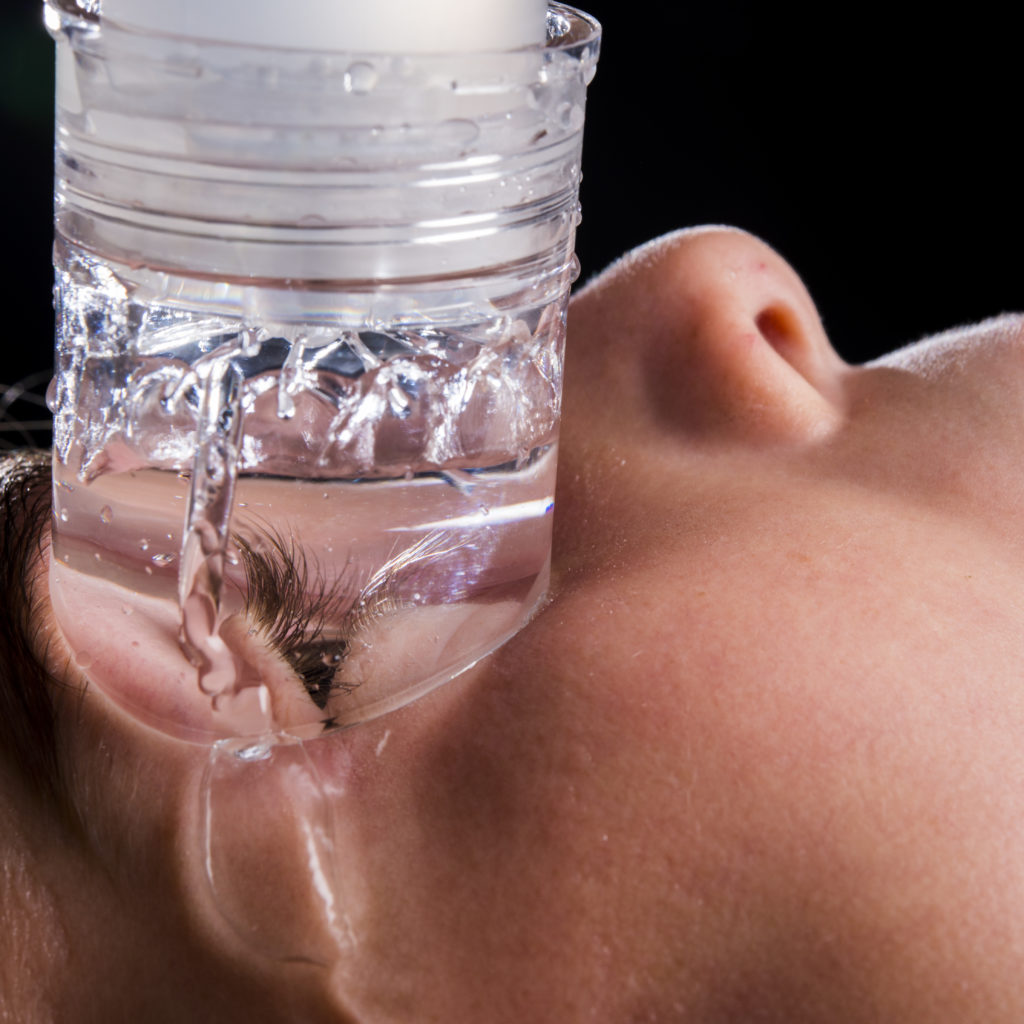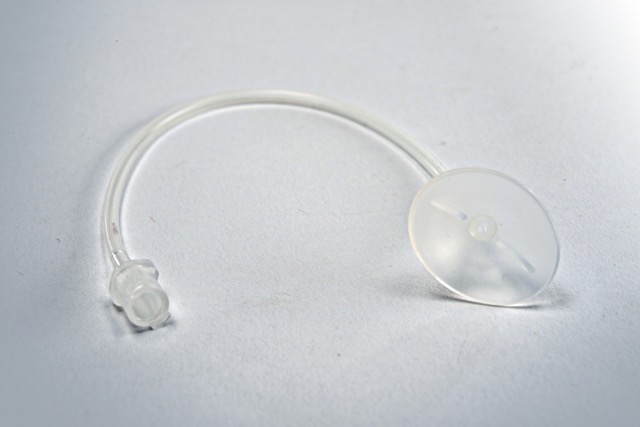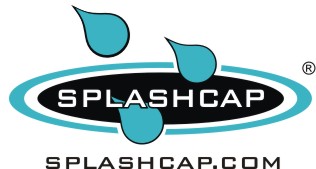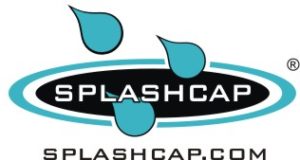EyeCap
Don’t Wait to Irrigate!
Use the EyeCap for instant eye irrigation. Use as a bridge to other eye irrigation methods that may be difficult for some patients to tolerate.
The spray coming from the EyeCap nozzle makes a “pool” of irrigation fluid, so patients can easily open their eyelids as if they were swimming underwater. This overcomes the blinking reflex, enabling the eye to remain open so the irrigation fluid can extend under the lids. It fits on standard Baxter irrigation bottles.
Use the EyeCap as definitive treatment for many of the minor irritants which can be washed away for immediate relief (e.g. pollen, smoke, mucus and work environment irritants) or to float out visible or invisible foreign bodies.
In more serious injuries, start with the EyeCap and use it as a bridge to IV bag irrigation techniques, including invasive irrigation lenses.
Whether it is a minor or major splash injury to the eye, use the EyeCap first to begin treatment and: “Stop the Sizzle!”
To learn more, please scroll down to review the information below.
Instant Eye Irrigation.
Faster Treatment.
Non-Invasive.
Simple to Use.
Kid Friendly.
A Bridge to More Invasive Irrigation Lenses.
Scroll Down
Scroll Down
STOP THE SIZZLE!
don't Wait to Irrigate!
Need
Originally the EyeCap was designed as a bridge to using irrigation lenses for kids with splash injuries to the eye.
The EyeCap was developed to solve the need for a simple to use, portable device that could provide immediate relief to help stop the damage from chemical injuries. It also fills the need for a non-invasive device for minor eye injuries.
Just twist the EyeCap on a compatible irrigation bottle and you are ready to start irrigating
Better Patient Care & Patient Safety
The EyeCap provides better patient care by instantly delivering large volumes of fluid to the surfaces of the eye. Numbing drops are not typically used, so this avoids masking foreign bodies and helps with patient assessments. The EyeCap is non-invasive. It is simple and easy to use with minimal instructions. Using the EyeCap allows you to provide better more economical and efficient care for minor eye injuries. The EyeCap also allows you to quickly initiate treatment for more severe injuries.
Alternatives
It is well known that ocular irrigation is an important treatment for splash injuries and foreign bodies to the eye. Ocular irrigation procedures can very difficult for some children and adults to tolerate. There reasons may include the severity of the injury, extreme sensitivity of the eye, the pain associated with an eye injury, anxiety, blepharospasm, the type of irrigation equipment used, whether a large piece of plastic with an invasive nature is placed on an already injured eye, the type of irrigation fluid used, the length of the procedure, the age of the patient, the agitation of the patient, whether a patient has experience with contact lens and any whether pain and/or sedation medications are used to help a patient overcome any these issues.
Irrigation alternatives may not work well. For example, IV cannulas dripping saline into the eye would cause a patient to “blink”. A patient may keep their eyes closed so fluid then would not get in their eyes. The result would also happen when using a syringe to flush water directly into the eye. Even mandated eyewash stations, which are very rarely used in ER’s, impact the eye causing the lids to reflexively remain closed.
EyeCap Design
The EyeCap is designed to fit on compatible irrigation pour bottles. It has a wide saddle rim to fit comfortably over the orbit. The unique patented nozzle creates an indirect spray and a pool of fluid. This helps overcome the blinking reflex because there is no direct impact on the eye. The raised outlet port allows continuous irrigation and ongoing dilution. The EyeCap provides immediate relief to prevent ongoing injury from chemical splash injuries, by decontaminating the outer and inner surfaces of the lids quickly and effectively.
First Aid
Use the EyeCap first. Even when there are major splash injuries, the EyeCap is still the best first line treatment in the ER, since it can be started much faster and easier than setting up some other irrigation methods. Use the EyeCap first to instantly begin treatment and buy time for using more prolonged irrigation methods if needed. The EyeCap works well for kids and adults. Use it in the hospital, clinic or pre-hospital setting, where ever standard saline pour bottles are available.
Along the way, many clinical providers have used the EyeCap on themselves after a body fluid exposure or contact with a hospital irritant when accessing an eyewash station was not convenient or practical.
Avoid Unnecessary Use of Numbing Drops
Using the EyeCap does not require the use of numbing drops. Therefore the masking consequences of ocular anesthetic drops can often be avoided. For example, the EyeCap can be safely used when a foreign body is suspected. When a splash injury occurs, the presence of a associated foreign body should be considered. Numbing drops can mask pain, mask a foreign body sensation and interfere with your clinical assessment. Using numbing drops could also mask the pain associated with an embedded or small protruding foreign body could interfere with the use of irrigation lenses.
Of course, there are benefits and reasons to use ocular anesthetics. They are sometimes necessary to relieve blepharospasm to get the patient to open their eyes for an adequate eye exam if a foreign body is suspected.
Also, the first step of the instructions for use of irrigation lens is to instill ocular anesthetics, if available.
On the other hand, if a patient with a minor splash injury to the eye feels better and looks better after a brief bottle irrigation without numbing drops; then chances are they are better.
Escalating Clinical Treatment
We recommend using the EyeCap first for nearly all splash injuries. However, if an injured patient continues to be in pain after using the EyeCap and needs numbing drops for relief or has other significant signs or a significant history, you should strongly consider escalating to more prolonged irrigation techniques such as invasive irrigation lenses.
Save Time
Begin irrigation in seconds. Just twist on a compatible irrigation bottle and squeeze. It’s that simple. The EyeCap makes it easy and simple to deliver large volumes of fluid to the eye in seconds.
Unlike IV fluid techniques, there are no IV bags to set up with extension tubing, priming and assembly. Unlike irrigation lens, there is no need to spend time explaining to a concerned patient why you are going to place a large piece of plastic on the surface of an eye that is already injured.
Steps
Begin with irrigating the external surfaces of the eye. Quickly lift the EyeCap off the surface to release the initial irrigation fluid, then keep sealed over the eye surface. Repeat. After the external surfaces of the eye are irrigated, keep the EyeCap sealed over the orbital surface and create a pool of fluid. The patient can open their eyes as if they were in a swimming pool. Patients will often need help to open their eyes. This can be done by prying the lids apart even a little bit. Once the lids are open, the overlying fluid floods the eye surface. There is typically a significant relief of pain and anxiety with this initial soaking of fluid; and the patients become more comfortable and cooperative.
Flush the opposite eye if treatment is also needed. Use a new bottle of fluid or use tap water to refill. Irrigate 500 to 1000ml per side and reassess the need to continue treatment or wrap it up.
This can be done in 1 to 2 minutes from start to finish for a minor injury.
Save Money
Preventing damage to the eye is priceless … but let’s review some of the costs:
An Irrigation lens costs about twice the amount of a single EyeCap. A single eye cap will typically be used to treat two eyes, whereas two separate irrigation lens are typically used when two eyes need treatment. When two eyes need to be treated for a minor injury, the cost of using the EyeCap would be 25% of the cost of using irrigation lens.
Of course, the comparison above does not factor in the additional costs associated with accessory equipment, the fluid used, any medications used and staff resources, particularly for a lengthy irrigation process. Likewise, if there is a potentially more serious injury of two eyes, we would typically recommend the use of the EyeCap first and then moving on to a prolonged irrigation technique. In such a case, the comparison of the costs would obviously not apply since it would be a combination the two techniques used. Of course prices vary, so check with your distributors to verify these estimates.
Also, time is money in the Emergency Room setting. If you can quickly and definitively treat a patient with a minor splash injury and get them on their way with a lower turnaround time, the patient is happy and so is your department manager

Save Time
Begin irrigation in seconds. Just twist on a compatible irrigation bottle and squeeze. It’s that simple.
The EyeCap makes it easy to deliver large volumes of fluid to the eye in seconds.
After the external surfaces of the eye are irrigated, the patient can open their eyes underwater like in a swimming pool.
Patients will often need help to first open their eyes. This can be done by prying the lids apart even a little bit. Once the lids are open, the overlying fluid floods the eye. There is typically significant relief of pain and anxiety and the patient becomes much more cooperative.

IV Fluid Treatments
Unlike when using a nasal cannula technique or an irrigation lens (as shown to the left) , there are no IV bags to set up with extension tubing when using the EyeCap. There is no need to try to explain to a patient why you are going to put a large piece of plastic on the surface of an injured eye.
Ocular irrigation with irrigation lenses on children and adults can sometimes be difficult to tolerate. There are many possible reasons for this, including the irrigation fluid chosen. While normal saline (NS) is probably the most common ocular irrigation fluid used, some recommend lactated Ringers (LR) since it is thought to be less painful and has buffering capacity. As with any medical device, make sure anyone using it has the proper training and adheres to the manufacturer’s detailed instruction for use to avoid any further injury to the eye.

So Simple
Bottle.
EyeCap.
Squeeze.
Scroll Down

How Does it Work?
The rounded edge of the saddle rim seals against the orbit.
Fluid sprays outward to the side wall and trickles down to create a pool of fluid.
The volume of the of fluid provides dilution to bathe and soothe the eye.
The pooled fluid can soak under the lids when the lids are even slightly separated.
The side port allows run-off for continuous irrigation.
What's the PSI?
ZERO.
There is no direct impact on the eye.
The spray stream
aims at the sidewall and trickles down.
Contact Info Below
“…thinking outside the docs”

order now
Place Your Order!
Click Icon
info@splashcap.com
telephone
404-252-5442
location
Atlanta, GA 30342
legal notices
Patented
Patent Pending
Reg.Trademarks, etc
Click Icon for More Info

